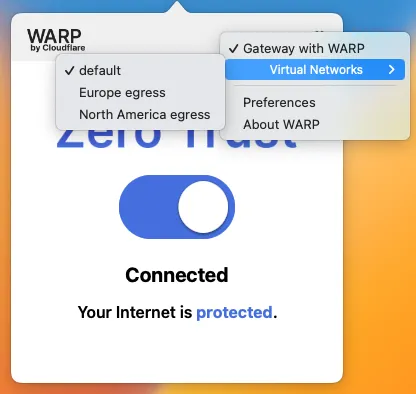Egress IP best practices
When you turn on dedicated egress IPs for your account, Cloudflare will automatically balance all of your user traffic between your IPs depending on a few factors, including your user's physical location and the location of the resource that they are currently requesting. For example, if you have egress IP locations in Amsterdam, London, and Washington, D.C. and have not configured any policies, Cloudflare will assign the following egress IPs to your users:
- Amsterdam egress IP to users near the Netherlands
- London egress IP to users near England
- Washington, D.C. egress IP to users in North America
Because of Cloudflare's network design, your users will still take the fastest possible route on the Cloudflare network to reach their destination. The addition of an egress IP will add minimal latency in most scenarios.
Cloudflare recommends reserving distributed IPs in areas that most accurately match your users' physical locations. For example, if all of your users are in North America, you should consider a series of IPs in various North American data centers to ensure redundancy and performance for all of your users.
You should also reserve multiple egress IPs if you have locations that need explicit egress. For example, if you have users who need to egress out of London and cannot fall back to Dublin, you will need to deploy multiple IPs in various London locations to ensure redundancy. Separately, you would need to build a policy relevant to all users with this requirement to ensure all of their traffic egresses with one of your London egress IPs.
One of the most common use cases for egress policies is to ensure a consistent egress IP for users accessing SaaS applications that may not support SAML (or vendor services that can only use IP-level controls). If given the option -- or if your business controls the application -- Cloudflare strongly recommends using Cloudflare Access to move from IP-level authentication to identity-aware authentication that uses continuous evaluation.
We recommend building baseline egress policies that can cover a majority of your use cases without making policy management overly complex. If all of your users need to access a series of applications that all require a specific egress IP, you should build a policy explicit to those users (or to all of your users) to ensure that all of their traffic egresses using those egress IPs. For example, you can define specific egress IPs for users with access to financial data:
| Selector | Operator | Value | Egress method |
|---|---|---|---|
| User Group Email | in | Finance Users | Use dedicated Cloudflare egress IPs |
| Primary IPv4 address | IPv6 address |
|---|---|
203.0.113.0 | 2001:db8::/32 |
curl https://api.cloudflare.com/client/v4/accounts/{account_id}/gateway/rules \--header "Authorization: Bearer <API_TOKEN>" \--header "Content-Type: application/json" \--data '{ "action": "egress", "description": "Define static egress for finance team", "enabled": true, "filters": [ "egress" ], "name": "Finance team static egress", "precedence": 0, "identity": "any(identity.groups.name[*] in {\"finance\"})", "rule_settings": { "egress": { "ipv4": <DEDICATED_IPV4_ADDRESS>, "ipv4_fallback": <SECONDARY_DEDICATED_IPV6_ADDRESS>, "ipv6": <DEDICATED_IPV6_ADDRESS> } }}'You may have use cases in which specific groups of your users may need to change the location from which they egress. Cloudflare observes this frequently with quality assurance (QA) teams for applications or sites that need to test resources as if they are accessing from different, predetermined locales. You can manage this when necessary via an egress policy, but most Cloudflare users prefer to manage this without ongoing changes to the administrative panel and existing policies. To accommodate this, you can build virtual networks for use as selectors in egress policies. This will allow your users to change their attached virtual network and subsequently change their egress IP as they choose.

For more information, refer to our tutorial for user selectable egress IPs.